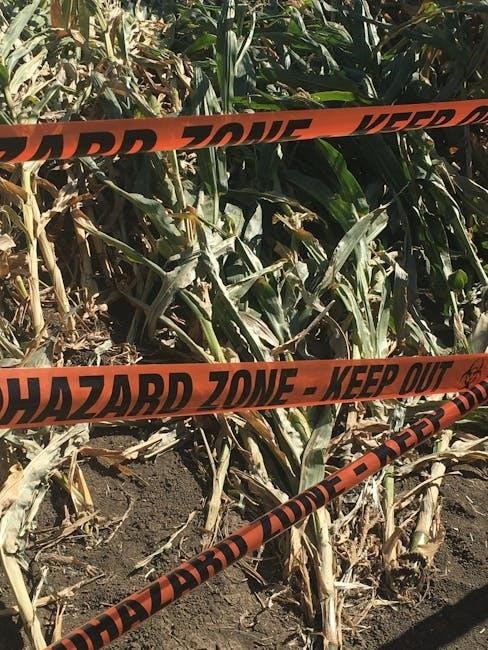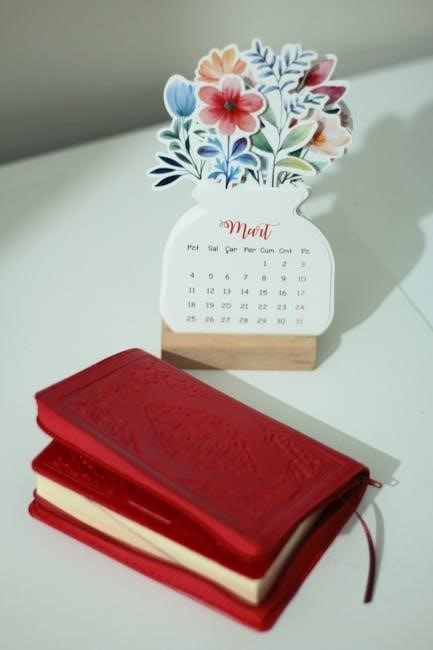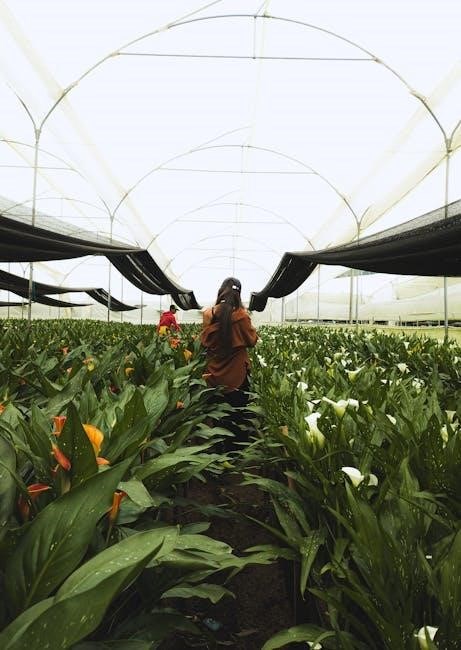Welcome to the Zone 8b planting schedule guide! This comprehensive resource helps gardeners maximize their growing season with detailed planting and harvesting timelines for vegetables, fruits, herbs, and flowers. Perfect for both experienced gardeners and newcomers, this schedule ensures optimal growth and bountiful harvests year-round in USDA Zone 8b.
Understanding USDA Hardiness Zone 8b
USDA Hardiness Zone 8b is a specific region defined by its average annual extreme minimum temperature, ranging from 15°F to 20°F (-9°C to -7°C). This zone enjoys a relatively long growing season, with last frost dates typically around mid-March and first frost dates in early November. These dates are crucial for determining planting schedules, as they indicate when it is safe to start or stop growing specific plants. Zone 8b’s mild winters and warm summers make it ideal for growing a wide variety of plants, including vegetables, fruits, herbs, and flowers. Understanding this zone’s climate and frost patterns is essential for successful gardening and maximizing harvests throughout the year.
Importance of Planting Schedules for Zone 8b
Planting schedules are vital for Zone 8b gardeners to ensure optimal growth and productivity. By following a tailored schedule, gardeners can align planting times with the region’s climate, avoiding frost damage and maximizing the growing season. This guide helps in selecting the right plants for each season, ensuring they mature before the first frost. It also allows for successive plantings, enabling year-round harvests. A well-planned schedule reduces the risk of crop failure and enhances overall garden performance, making it an indispensable tool for both experienced gardeners and newcomers. Proper timing ensures that plants thrive, leading to healthier crops and higher yields in Zone 8b’s favorable climate.

Key Considerations for Planting in Zone 8b
Understanding frost dates, soil preparation, and temperature requirements is crucial for successful gardening in Zone 8b. The region’s long growing season and mild winters allow for year-round planting, but timing is essential to avoid frost damage and ensure optimal growth.
Last and First Frost Dates in Zone 8b
In Zone 8b, the last frost date typically occurs around mid-March, while the first frost date is usually in early November. These dates are critical for gardeners, as they determine the optimal planting times for various crops. The average annual minimum temperature in Zone 8b is 15°F, which influences plant hardiness and growth. By understanding these frost dates, gardeners can avoid planting sensitive crops too early or too late, ensuring they are not damaged by unexpected frosts. This knowledge also helps in planning the planting schedule effectively, maximizing the growing season, and achieving successful harvests throughout the year.
Annual Minimum Temperature and Its Impact
In USDA Zone 8b, the annual minimum temperature averages around 15°F, a critical factor for plant hardiness and growth. This temperature threshold determines which plants can survive winter conditions without protection. Understanding the annual minimum temperature is essential for selecting appropriate plants and ensuring their survival. It also influences the timing of planting and harvesting, as certain crops may require protection or relocation during colder months. The relatively mild winters in Zone 8b allow for a wide variety of plants to thrive, but awareness of this temperature is vital for gardeners to make informed decisions. This data is a cornerstone of the Zone 8b planting schedule PDF, helping gardeners align their efforts with local climate conditions for optimal results.

Seasonal Planting Schedule for Zone 8b
Zone 8b offers a long growing season with mild winters, allowing year-round gardening. This schedule guides planting in spring, summer, fall, and winter for optimal year-round productivity.
Spring Planting in Zone 8b
Spring planting in Zone 8b begins as early as late winter, with the last frost date typically around mid-March. This period is ideal for planting cool-season crops like broccoli, spinach, and lettuce, which thrive in cooler temperatures. Gardeners can also start seedlings indoors for warm-season plants like tomatoes and peppers, transitioning them outside after the last frost. Herbs such as basil and cilantro do well in Zone 8b’s spring climate. The mild winters allow for early planting, giving gardeners a head start on the growing season. By following the Zone 8b planting schedule, gardeners can ensure optimal growth and maximize their harvests throughout the spring months.
Summer Planting in Zone 8b
Summer planting in Zone 8b thrives in the warm weather, with long days and high temperatures ideal for heat-tolerant crops. Tomatoes, peppers, eggplants, and okra are excellent choices for summer gardens. Herbs like basil, mint, and dill also flourish during this season. Planting in early summer ensures crops mature before the heat becomes extreme. Soil moisture management is crucial, as Zone 8b’s dry summers can stress plants. Mulching and consistent watering help retain soil health. Additionally, summer is a great time to plant successive crops of beans, cucumbers, and squash for continuous harvests. By following the Zone 8b planting schedule, gardeners can make the most of the summer growing season and enjoy a bountiful yield.
Fall Planting in Zone 8b
Fall planting in Zone 8b is a great opportunity to grow cool-season crops, taking advantage of the mild winters and long growing season. Vegetables like broccoli, kale, spinach, and carrots thrive in the cooler temperatures. Plant these 8 weeks before the first frost date, which typically falls between late November and early December. Herbs such as parsley, cilantro, and dill also do well in fall. Additionally, flowers like pansies and violas can be planted for vibrant winter color. The key is to choose varieties that mature quickly and tolerate light frosts. Proper soil preparation and consistent watering ensure healthy growth. By following the Zone 8b planting schedule, gardeners can enjoy a productive fall harvest and extend their gardening season into winter.
Winter Planting in Zone 8b
Zone 8b’s mild winters make it an ideal location for winter planting. Cool-season crops like spinach, kale, and Brussels sprouts thrive during this time. Plant these 8-10 weeks before the first frost date, which is typically late November to early December. Root vegetables such as radishes and turnips also grow well in Zone 8b’s winter. Herbs like parsley and cilantro can be planted for fresh winter harvests. Additionally, garlic and onions can be planted in late fall for a summer harvest. Use cold frames or row covers to protect plants from occasional frosts. Proper soil preparation and consistent moisture are key for successful winter gardening. The Zone 8b planting schedule PDF provides detailed guidance for maximizing your winter garden’s potential.

Vegetable Planting Guide for Zone 8b
Zone 8b’s long growing season supports a wide variety of vegetables. Popular choices include tomatoes, peppers, cucumbers, and leafy greens. The planting schedule PDF offers detailed timing for optimal growth and harvest success.
Best Vegetables to Grow in Zone 8b
Zone 8b’s mild winters and long growing season make it ideal for a wide variety of vegetables. Tomatoes, peppers, and cucumbers thrive in the warm summers, while leafy greens like kale and spinach excel in cooler seasons. Root vegetables such as carrots, beets, and radishes also grow well. Broccoli, cauliflower, and Brussels sprouts are excellent choices for fall gardens. Herbs like garlic, onions, and mint are perfect for year-round cultivation. The Zone 8b planting schedule PDF provides detailed guidance on when to plant these vegetables for optimal growth and harvest. With proper planning, gardeners can enjoy fresh produce throughout the year in this favorable climate zone.
Optimal Planting Times for Vegetables
In Zone 8b, the optimal planting times for vegetables are divided into spring, summer, and fall. Start with cool-season crops like spinach, lettuce, and carrots in early spring, about 4-6 weeks before the last frost date. Warm-season crops such as tomatoes, peppers, and cucumbers should be planted after the last frost date, typically mid-March. Summer is ideal for heat-tolerant varieties like okra and eggplant. For a fall harvest, plant broccoli, kale, and radishes in late summer to early fall, 8-10 weeks before the first frost date. Root vegetables like beets and turnips also thrive in cooler fall weather. Herbs like garlic and onions can be planted in fall for a winter harvest. The Zone 8b planting schedule PDF provides precise timing for each vegetable to ensure maximum yield and flavor.

Fruit and Berry Planting in Zone 8b
Zone 8b offers ideal conditions for growing a variety of fruits and berries. Strawberries, blueberries, raspberries, and blackberries thrive in the region’s mild winters and warm summers. Citrus trees, like lemons and oranges, also grow well in Zone 8b. Plant most fruit trees in early spring or late winter for optimal results. Berries can be planted in early spring or fall, depending on the variety. The Zone 8b planting schedule PDF provides detailed timing for specific fruits and berries to ensure successful growth and abundant harvests.
Recommended Fruits for Zone 8b
Zone 8b’s mild winters and warm summers make it an ideal location for growing a wide variety of delicious fruits. Popular choices include strawberries, blueberries, raspberries, and blackberries, which thrive in the region’s climate. Citrus trees, such as lemons, oranges, and grapefruits, also grow exceptionally well in Zone 8b. Peaches, nectarines, and apricots are excellent options for gardeners seeking stone fruits. Grapes, both table and wine varieties, are another great choice for the area. These fruits benefit from the zone’s long growing season and generally mild temperatures. By selecting the right fruit varieties and following the Zone 8b planting schedule PDF, gardeners can enjoy fresh, homegrown produce year-round.
Planting and Harvesting Times for Fruits
Understanding the optimal planting and harvesting times for fruits in Zone 8b is essential for a successful garden. The last frost date, typically around mid-March, marks the start of the growing season. For fruits like strawberries, planting in early spring ensures a summer harvest. Blueberries, raspberries, and blackberries thrive when planted in late winter to early spring, with harvests in late spring to early summer. Citrus trees, such as lemons and oranges, are best planted in spring or fall and take several years to mature. Peaches, nectarines, and apricots should be planted in late winter, with fruit ready by mid to late summer. Grapes are planted in early spring and harvested in late summer to early fall. By following these timelines, gardeners in Zone 8b can enjoy a bountiful and diverse fruit harvest.

Herb and Flower Planting in Zone 8b
Zone 8b offers a long growing season, ideal for herbs like basil, rosemary, and mint, and flowers such as marigolds and zinnias. Plant in spring or fall for optimal growth.
Popular Herbs for Zone 8b Gardens
Zone 8b gardens thrive with a variety of herbs that love the mild winters and warm summers. Popular choices include basil, rosemary, mint, cilantro, dill, parsley, oregano, thyme, garlic chives, and lemongrass. These herbs are well-suited to the region’s climate and can be planted in early spring or fall for optimal growth. Many of these herbs are perennials, returning year after year, while others, like basil and cilantro, are annuals that require seasonal planting. Planting herbs in well-drained soil with ample sunlight ensures robust growth and flavorful harvests. Incorporating these herbs into your garden adds fresh flavors to your kitchen and enhances your garden’s biodiversity.
Flowering Plants Suitable for Zone 8b
Zone 8b offers ideal conditions for a wide variety of flowering plants, ensuring vibrant blooms throughout the year. Popular choices include marigolds, zinnias, sunflowers, lavender, coneflowers, black-eyed susans, and lantanas. These plants thrive in Zone 8b’s mild winters and warm summers, requiring minimal care. Many of these flowers are drought-tolerant and attract pollinators like bees and butterflies, enhancing garden biodiversity. Planting in early spring or fall is recommended for optimal growth. Ensure well-drained soil and ample sunlight for most flowering plants. Incorporating these into your garden creates a colorful, dynamic landscape that blooms across the seasons, adding beauty and life to your outdoor space year-round.

Downloadable Zone 8b Planting Schedule PDF

Download your free Zone 8b planting schedule PDF for a comprehensive guide to optimal planting times, ensuring a thriving garden year-round with detailed seasonal advice.
How to Use the Zone 8b Planting Schedule PDF
The Zone 8b planting schedule PDF is a valuable tool for gardeners, providing detailed planting and harvesting timelines for vegetables, fruits, herbs, and flowers. To use it effectively, start by identifying your specific plants of interest and cross-reference them with the recommended sowing and harvest dates. The PDF also includes tips on soil preparation, sunlight requirements, and spacing for optimal growth. Use the monthly planting calendar to plan ahead and ensure your garden remains productive year-round. Additional resources, such as care tips and troubleshooting guides, are often included to help address common challenges. By following the schedule, you can maximize your garden’s potential and enjoy a bountiful harvest in Zone 8b.

Additional Resources for Gardeners
Beyond the Zone 8b planting schedule PDF, gardeners can access a wealth of resources to enhance their gardening experience. Websites like Kellogg Garden offer detailed planting charts and care tips tailored to specific zones. Sowing calendars for vegetables and herbs provide month-by-month guidance, ensuring timely planting and harvesting. Many gardening communities and forums share personal experiences and solutions to common challenges. Local nurseries and extension services often provide region-specific advice, complementing the PDF guide. These resources empower gardeners to make informed decisions, troubleshoot issues, and explore new techniques for a thriving garden in Zone 8b.